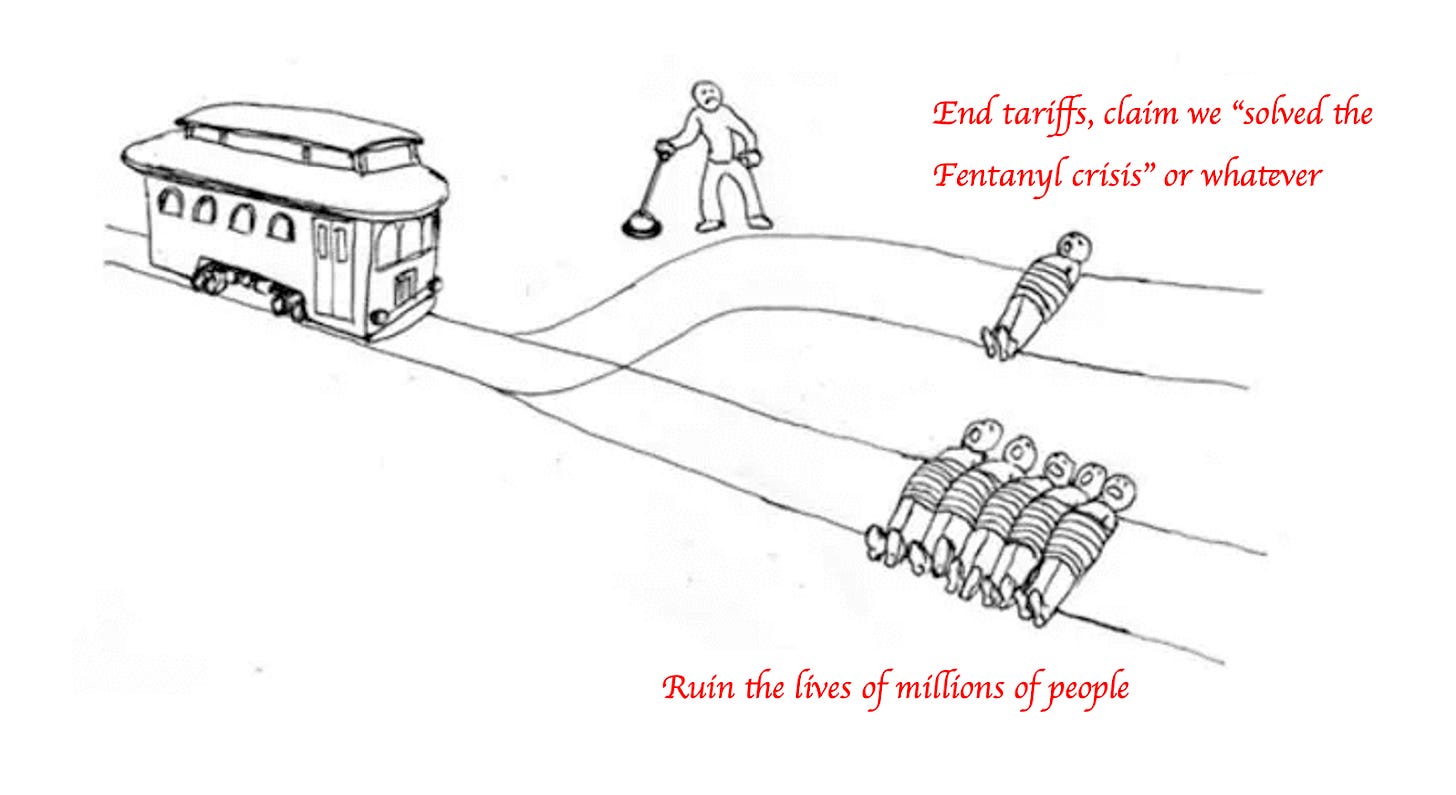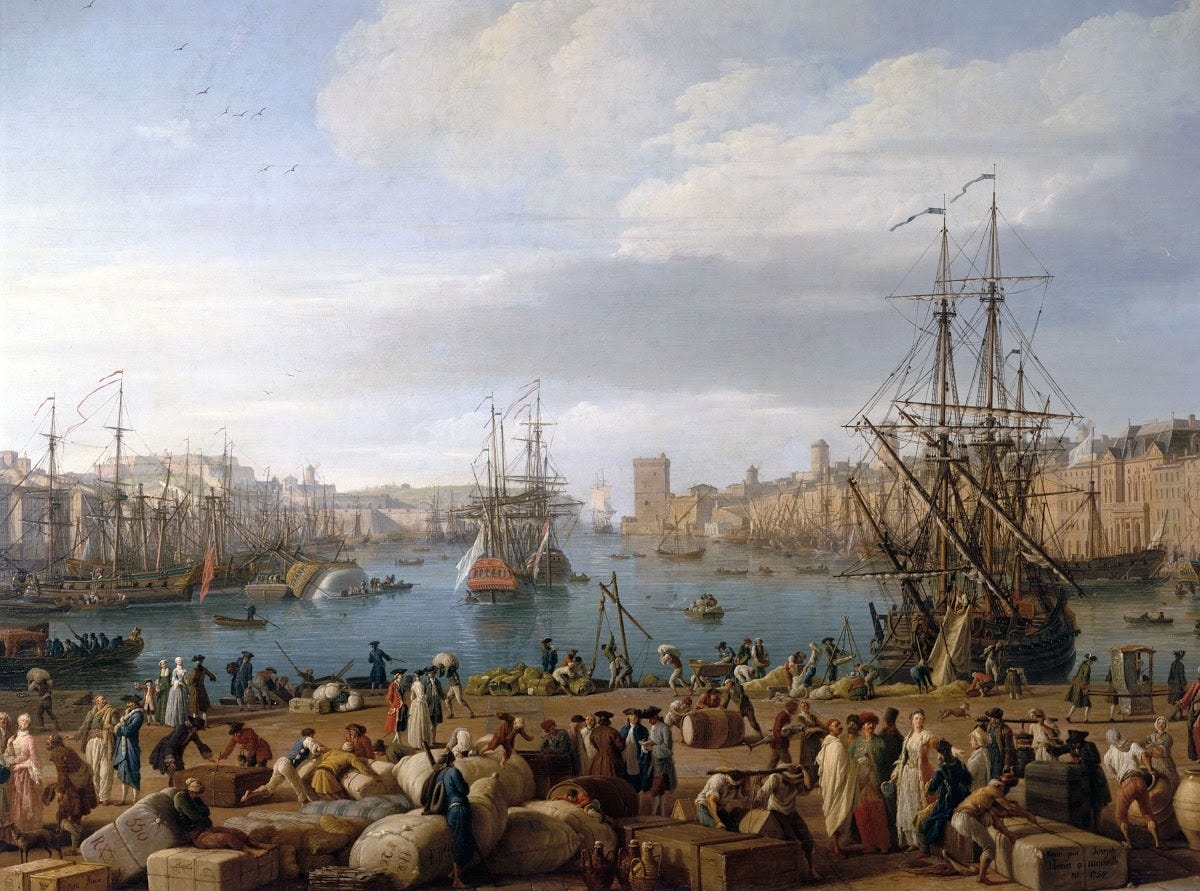The implications of fewer container shipments
Biden's “economic overhang,” kids with 30 Barbies, cocktail buckets
The first dominos have fallen in the trade war, but no one knows where the trail leads. The more blatant dropshipping sites (Temu, Aliexpress, and Shein) have raised their prices, turning an $86 cardigan into a $226 purchase, while more high-brow sites like Sezane are broadcasting warning messages about raising prices (which is sure to hit the French bob girlies hard). But perhaps the real dominos are the cargo boats that never left their ports in Shenzhen. The Wall Street Journal reports that bookings for trans-Pacific trade are down by at least a third.
If you need something like masks for the hospital you run or critical machines like CNCs for the factory you’re thinking of opening, you will likely have a difficult time this summer. Even the most gun-hoarding preppers need pencils for their manifestos–but graphite has not been mined in the US since the 1950s. Increasingly it appears that even the most skeptical reader is hurtling towards a Depression-era combination of “out of stock” signs and exorbitantly-priced goods.
Commerce Secretary Lutnick told us on the “All In” podcast that “inflation doesn’t come from tariffs, it comes from printing more money” – which makes one wonder if he has considered tariffs as a definitional concept, or even the implications of the President’s near-daily demand to lower interest rates. The Administration is caught in a rhetorical bind between a “negotiating tool” that results in a trade deal in a few weeks or a “manufacturing incentive” that would crash the global economy for a million or so manufacturing jobs in the long run (funny, given he canceled funding for green manufacturing – in largely red states and for projects which were actually ready for lift-off).
The best case scenario is all this gets dropped and forgotten about because the CEO of Cartel Enterprises donates enough money to a Republican electoral campaign or World Liberty Financial’s crypto coins (as the Saudis have). And the critical reader will likely say: we saw a lot of market turmoil around April 2 that scared Trump, so he’s unlikely to pursue an aggressive strategy again.
And while there may be some truth to the idea: then why hasn’t he dropped the approximately 150% tariffs on Chinese goods, those that pose an immediate threat to global trade? Why continue on this gambit? He is reactive to media, but not as reactive as to be a better person. (1) We saw a first-quarter GDP print that was negative, and his administration just blamed the “Biden overhang” (which is pretty funny, even Wall Street got a real kick out of it, because if there is an “overhang,” it’s what is saving the labor market right now). Conventional management of key economic indicators doesn’t seem to be a priority. And (2) due to how shipping works, it isn’t quite that simple.
Sea freight, the most common (and cheapest) way to ship goods from China, often takes around 30-40 days to ship goods from Chinese ports to the US (time varying somewhat based on port distances, stops made, time spent in customs, etc.). Basically, once a container of stuff from China is unloaded in a port in the US, then it takes a few days more to get to the bodega where you buy your bananas. And already, shipping is down over 40%. I don’t mean to fearmonger, because obviously things could change very quickly, but I mean to use this space to understand what has already happened and how we can use that to infer future impacts. As big-box stores face thinning shelves in the coming months, even if Trump were to change his rhetoric on trade, it would take over a month for a shelf to fill up again. The lag between hastily-written Executive Order and your ability to buy a Toyota Corolla for under $50,000 isn’t immediate. In other words, some damage may already be done.
Because have we really considered the implications of having fewer things to buy?
On one hand, America may be better off without environmentally-destructive goods, cheap only as profound as the labor exploitation that went into their production. But as food, medicine, and other necessities rise in price, the struggles of the worst off among us stand to be intensely amplified.
I’ve often heard it theorized that Americans love cheap goods because it allows them to ignore stagnant wages. It’s not crazy – if you told a 14th century peasant that almost any American household could afford air conditioning and a refrigerator, they’d think you were a King, or at least one of the lesser Lords. We now may be in for a distinct cultural reversal – one that takes the phrase “less is more” and considers it as less a design heuristic and more a necessary manner in which to live life. (As I have mentioned before, I recommend Emily Mester’s book American Bulk, for compassionate, literary thinking on the American tradition of bulk-buying non-necessities.). Culturally, Tiktok’s huge “Buy Nothing” viral trend (where young people champion the positive environmental, fiscal, and mental benefits of limiting consumerist impulses) dovetails neatly with Trump’s (hilarious) suggestion that children have “two, instead of thirty Barbies” to play with.
I’d like to say that this is the time for Democrats to show how there may be benefits in reconsidering the prevailing growth narrative and considering how progress could be reconceptualized as one that is more rooted in equality of access or opportunity. But it feels fundamentally dishonest not to acknowledge that fewer things in general probably has downstream implications of fewer things that we need. Excess may be bad, almost definitionally, but overcorrection risks shortages never before seen in American life.
Or at least not seen since that one traumatic event we can still barely bear discussing.
Because there are a lot of uncomfortable parallels with the pandemic. Anyone else remember shopping on Instacart for the first time, trying to add some baked goods to your order cart and being hit with an “OUT OF STOCK” message? Getting vaccinated and seeing empty shelves at the bodega, because of some vague notions of supply chains being out of whack? I remember wiping down groceries with my roommate, because that was what they told us to do at the time, wondering if we would be able to pick out a rotisserie chicken from the store ourselves sometime soon, or when they would “bring things back” that previously I had taken for granted. I remember desperately craving a Friday night negroni with a friend, and so I waited in line outside of a dive bar for a $15 “cocktail bucket” which I would go home and split with my roommate. I knew that it wouldn’t taste very good, but we were all so broken by the moment and compelled to support those local businesses which we knew to be struggling, even if that meant standing in line in broad daylight waiting for a pricey fruit cocktail that we would drink in front of a Criterion movie neither of us would be able to pay much attention to.
Will the next moment be framed in the same message of unity against viral evil? Or will it be fraught with uprising and civil disarray one would expect if a leftist President severed all supply chains and told small businesses to fuck off?
Many smart people I know predict upheaval in six months, unless Trump pulls the right combination of trolley levers.
Your job, your retirement savings, your access to pineapples and matcha and foreign films (?) all hang in this balance.
With so much uncertainty, hoarding may not be the best solution, unless you’re unfortunate enough to be opening a bodega in the near future. Instead, consider finding alternatives to the goods you typically source from China, and think about what items you might be able to use less of in general. It’s really all we can do. Locking in any prediction about the economy right now feels a bit like throwing leaves into the wind and hoping they land at your friend’s house, so I have tremendous respect for the economists and public policy scholars who take the time to analyze Trump’s announcements for our benefit, knowing the likelihood that these announcements will change in the future. (Joey Politano, I’m looking at you.)
Because with shipping volumes already plummeting 40%+, some amount of change is around the corner. The pandemic taught us how quickly our assumptions about the world can shatter, but there doesn’t seem to be a viral enemy to unite against this time — just Truth Social pronouncements with real human consequences. Sure I’ll tell my friend’s baby to live with “two Barbies instead of thirty” but the real question is who will bear the burden when medications, affordable food, and basic materials grow increasingly scarce.
I’ve yet to hear a coherent vision from elected Democrats or Republicans how to exit this self-inflicted crisis. Democrats miss an obvious opportunity to reimagine prosperity beyond harmful consumerism, while Republicans gamble with baseline economic stability in pursuit of manufacturing jobs that seem unlikely to materialize. What will it take for either party to acknowledge that trade policy isn’t just a funny op-ed in Politico but the difference between food in the pantry and not? In the end it may take rows of empty Walmart shelves, reminiscent of the most difficult moments of the pandemic, to finally force the conversation we’ve been avoiding.




How do you budget each month for all the publications you are subscribed to? I had to make a tough decision to let my Bloomberg lapse :( I only have Spotify and Amazon that my whole family relies on.
This is a shame, but I most definitely had more than thirty Barbies. Such a good read, thank you!